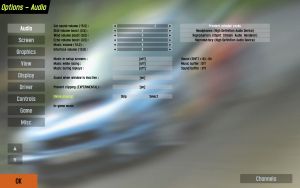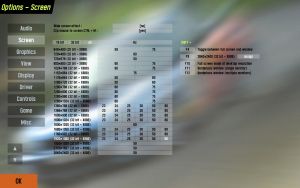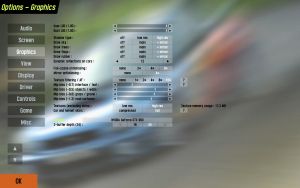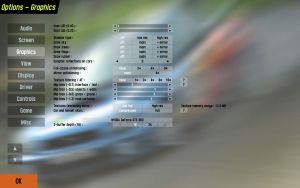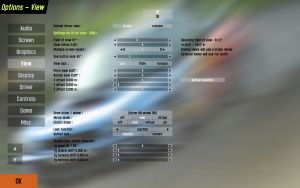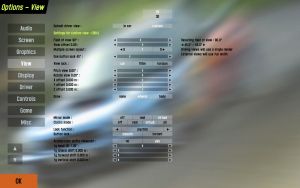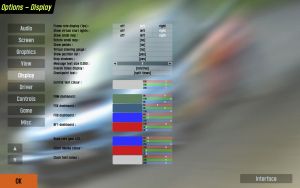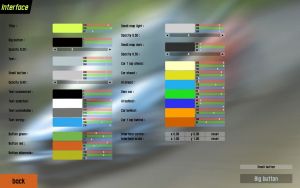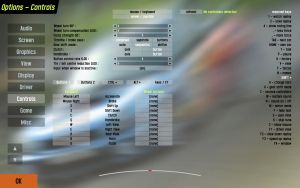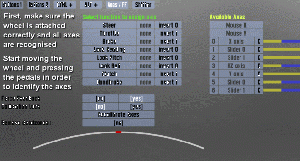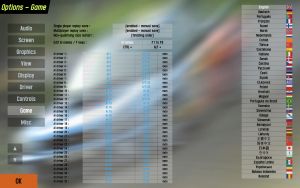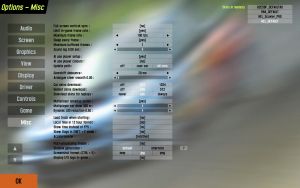Diferencia entre revisiones de «Opciones»
m (→Controls) |
|||
| (No se muestran 3 ediciones intermedias de 2 usuarios) | |||
| Línea 33: | Línea 33: | ||
Usando los botones 'Saltar' y 'Seleccionar' puedes elegir la canción que va a sonar. | Usando los botones 'Saltar' y 'Seleccionar' puedes elegir la canción que va a sonar. | ||
| − | + | '''Estilos:''' <br> | |
| + | LFS soporta playlists y aquñi puedes seleccionar cual deseas escuchar. | ||
| − | ''' | + | '''Canales:''' <br> |
| − | + | Usando este botón entraras en la interface para crear/editar playlists. El canal 1 es el standard para la música del menú y no puede ser eliminado. Puedes añadir, renombrar y borrar las demás playlist que tengas. A la izquierda puedes añadir pistas, asignar pistas a cada playlist y borrar pistas. Para asegurarte de que esa pista va a ser reproducida tienes que darle alta prioridad 3 usando las flechas, 1 es la menor prioridad, 2 es prioridad normal y "-" significa que esa pista no va a ser reproducida en esa playlist. A mas prioridad de una pista, mas probabilidad habrá de que suene. Esto significa que si tienes 2 canciones con la misma prioridad oiras las 2 con la misma frecuencia, pero si una tiene mas prioridad, esta se oira mas frecuentemente. | |
| − | '' | + | ''CONSEJO:'' Los archivos de música de LFS están en formato OGG Vorbis. Puedes crear tus propias canciones usando un conversor gratuito que podrás obtener en www.vorbis.com o usando otros programas. Para que el LFS pueda reproducir las canciones estas deben estar en el directorio ..\Data\Ogg . |
| − | |||
| − | + | == Pantalla == | |
| − | |||
| − | == | ||
[[image:Screen.jpg|thumb|Pantalla]] | [[image:Screen.jpg|thumb|Pantalla]] | ||
| − | + | En este menu puedes elegir la resolución deseada, la profundidad de color, la tasa de refresco y asignar diferentes comandos de teclas para diferentes configuraciones de pantalla. | |
| − | ''' | + | '''Mostrar modos de 32-bit:''' <br> |
| − | + | Al activar esta opción, se muestran las resoluciones de pantalla con profundidad para 32 bits. La profundidad de color estandar es de 16 bits. | |
| − | ''' | + | '''Pantalla 16:9 :''' <br> |
| − | + | Esto simula el efecto que se produce al ver peliculas normales de la TV en formato 4:3 pero poniendo dos bandas negras en la parte superior y inferior de la pantalla. | |
| − | ''' | + | '''Limitar el cursor a la pantalla CTRL+C:''' <br> |
| − | + | Si estas usando LFS en modo ventana, puedes hacer que el puntero del ratón salga de los bordes de la ventana. Esto puede suponer un problema si usas el ratón como dirección. Al activar esta opción se evita que el ratón salga de la ventana. Se puede activar/desactivar esta opción pulsando CNTRL+C. | |
| − | ''' | + | '''Teclas (SHIFT+):''' <br> |
| − | + | Esto te permite asignar una resolución, profundidad de color y tasa de refresco a cada asgnación de teclas desde el Shift+F9 al Shift+F12. Simplemente elige la configuración deseada y haz clic en uno de los botones. | |
| − | == | + | == Gráficos == |
[[image:Graphicsmax.jpg|thumb|Gráficos al máximo]] | [[image:Graphicsmax.jpg|thumb|Gráficos al máximo]] | ||
[[image:Graphicsmin.jpg|thumb|Gráficos al mínimo]] | [[image:Graphicsmin.jpg|thumb|Gráficos al mínimo]] | ||
| − | + | Las opciones en esta pantalla ajustan la calidad gráfica del juego. Una configuración adecuada de estas opciones puede incrementar el framerate o mejorar la calidad de la imagen. Ajustando las opciones puedes mejorar bastante la jugabilidad del juego si tu ordenador no es muy potente. | |
| − | |||
| − | |||
| − | |||
| − | |||
| − | |||
| − | |||
| − | |||
| − | |||
| − | |||
| − | |||
| − | |||
| − | |||
| − | ''' | + | '''Detalles:''' <br> |
| − | + | Esta opción es el 'Nivel de detalle', es decir, es la calidad de los objetos, texturas y la distancia a la que se dibujan. Las ruedas, por ejemplo, pueden parecer angulares (hexagonales, octogonales...) con un detalle bajo.<br> | |
| + | ''Rendimiento: 0.40 | Calidad: 1.00'' | ||
| − | ''' | + | '''Detalles del Retrovisor:'''<br> |
| − | + | Esto influye en la calidad del dibujado de lo que se ve por los retrovisores.<br> | |
| + | ''Rendimiento: 0.20 | Calidad: 0.40'' | ||
| − | ''' | + | '''Detalles Polvo/Humo:''' <br> |
| − | + | Con esto ajustas la calidad de las partículas de humo/polvo.<br> | |
| + | ''Rendimiento: 0.20 | Calidad: 1.00'' | ||
| − | ''' | + | '''Dibujar cielo:''' [Si / No] <br> |
| − | + | Elige la calidad con la que quieras que se muestre el cielo, si quieres que se muestre. Desactivando el cielo puede mejorar el rendimiento en ordenadores muy antiguos. | |
| − | ''' | + | '''Efecto niebla:''' [Si / No] <br> |
| − | + | Activa o desactiva el efecto niebla. Cuando esta activado, los objetos lejanos son dibujados con una leve niebla, incrementando la sensación de realismo. Al igual que con el cielo, si desactivas esta opción en ordenadores viejos puedes mejorar el rendimiento. | |
| − | ''' | + | '''Resolución de las sombras:''' [Off / Baja res / Alta res] <br> |
| − | + | Configura la resolución de las sombras de los coches. 'Off' desactiva las sombras completamente, 'Baja res' muestra las sombras con baja calidad para incrementar el rendimiento, 'Alta res' muestra las sombras con la calidad mas alta. Algunos ordenadores poco potentes pueden no soportar las sombras en alta resolución, pero por lo general no se suele tener problemas de rendimiento con ellas. | |
| − | ''' | + | '''Dibujar árboles:''' [Off / Escenario / +Espejos] <br> |
| − | + | Configura si los árboles deben ser dibujados. Elige si quieres que se dibujen y en caso de ser dibujados si también en los retrovisores. | |
| − | ''' | + | '''Dibujar banderas:''' [Off / Escenario / +Espejos] <br> |
| − | + | Configura si las banderas que hay alrededor de la pista deben ser dibujadas. Estas se pueden usar por ejemplo para saber la dirección del viento y su fuerza. Tienen un muy pequeño impacto en el rendimiento. | |
| − | ''' | + | '''Dibujar caucho:''' [Off / Escenario / +Espejos] <br> |
| − | + | Configura si quieres que se dibujen las marcas de derrape. Normalmente tienen un impacto muy pequeño en el rendimiento durante una carrera normal, con la excepción de que pueda haber un montón de derrapadas en un area reducido, como cuando se hacen ceros o quemadas de rueda. | |
| − | ''' | + | '''Filtro de texturas mip bias:''' <br> |
| − | + | Configura como son dibujadas las texturas en la distancia. 0.0 significa que las texturas se muestran difuminadas, mientras que con -4.0 se muestran poligonales. Sin embargo, las texturas poligonales pueden hacer que el dibujado sea mas granulado y molesto. Configuralo a tu gusto. | |
| − | ''' | + | '''Texturas (skins excluidos):''' [Baja res / Alta res] <br> |
| − | + | Configura si las texturas deben ser usadas en alta resolución o en baja. En ordenadores lentos es recomendable tenerla en baja si no tenemos suficiente rendimiento en alta. | |
| − | ''' | + | '''Skins de coches y cascos:''' [Comprimidas / Enteras] <br> |
| − | + | Configura si quieres que se compriman los skins o si prefieres dejarlos en alta calidad. Usando 'Comprimidas' reduces la calidad del skin, pero se puede incrementar el rendimiento si hay muchos coches en pantalla. | |
| − | '''Z-Buffer | + | '''Profundidad del Z-Buffer (24):''' [15 / 16 / 24 / 32] <br> |
| − | + | Basicamente con esto configuras como de grande es el Z-Buffer usado por la gráfica. Cuanto mayor sea el valor, mayor cantidad de buffer sera usado. Con una calidad baja significa que los objetos distantes estaran mas cerca entre ellos ya que la tarjeta gráfica puede no ser capaz de distinguir que objeto esta antes que el otro. No todas las profundidades de Buffer se pueden elegir en todas las tarjetas gráficas. Lo mejor es poner el mayor valor posible. | |
== View == | == View == | ||
| Línea 411: | Línea 400: | ||
== Game == | == Game == | ||
| − | [[image:Game.jpg|thumb| | + | [[image:Game.jpg|thumb|Juego]] |
Here we set some minor options such as the automatic/manual saving of races, the finishing order for race restarts etc - We can substitute names for the AI, maybe we want to race against Peter Brock or Michael Schumacher? Just click to cycle through the available options of each selection. The most important feature however, is the ability to add to the F1 - F8 keys of your own custom messages, such as “Sorry”, Hello, etc for use when in game and too busy to type a reply etc. To do this, select the "F1 to F8" button and in the space next to the selected key, click to open, then type in your message text, click OK to save. There is a limit on length etc, but most short messages can be written. | Here we set some minor options such as the automatic/manual saving of races, the finishing order for race restarts etc - We can substitute names for the AI, maybe we want to race against Peter Brock or Michael Schumacher? Just click to cycle through the available options of each selection. The most important feature however, is the ability to add to the F1 - F8 keys of your own custom messages, such as “Sorry”, Hello, etc for use when in game and too busy to type a reply etc. To do this, select the "F1 to F8" button and in the space next to the selected key, click to open, then type in your message text, click OK to save. There is a limit on length etc, but most short messages can be written. | ||
Revisión actual del 03:13 13 jun 2010
Audio
Este menú permite que cambies el volumen de la música y de los varios sonidos.
Volumen de sonidos del coche:
Controla el volumen de todos los sonidos música en relación con del coche y los sonidos de la interfaz. Si corriendo experimentas un sonido del motor de chisporroteo, baja este valor.
Volumen del derrape:
Eleva el volumen para hacerlo más fácil de oir. Ponlo en 0.0 para el volumen 'realista' y 1.0 para el 'aumentado'.
Volumen del aire:
Como lo anterior, pero con el viento. Fijate en que el volumen del aire es más alto en coches sin techo que en los carrozados. El ajuste predeterminado y 'realista' es 0.0.
Volumen del eco:
Esto ajusta el volumen del efecto del eco. El valor predeterminado es 0.0 y debería ser realista pero por supuesto puedes ajustarlo a tu gusto. Sin embargo, valores más altos pueden causar chasquidos.
Volumen de la música:
Volumen en el menú y dentro del juego.
Volumen de la Interfáz:
Volumen de los sonidos de la Interfáz, como el clic en un botón, etc.
Música en la pantalla setups:
Activa o desactiva la música en esa pantalla.
Música mientras conduces:
Activa o desactiva la musica en pista.
Música durante los replays:
Activa o desactiva la musica durante los replays.
Escoge canción:
Usando los botones 'Saltar' y 'Seleccionar' puedes elegir la canción que va a sonar.
Estilos:
LFS soporta playlists y aquñi puedes seleccionar cual deseas escuchar.
Canales:
Usando este botón entraras en la interface para crear/editar playlists. El canal 1 es el standard para la música del menú y no puede ser eliminado. Puedes añadir, renombrar y borrar las demás playlist que tengas. A la izquierda puedes añadir pistas, asignar pistas a cada playlist y borrar pistas. Para asegurarte de que esa pista va a ser reproducida tienes que darle alta prioridad 3 usando las flechas, 1 es la menor prioridad, 2 es prioridad normal y "-" significa que esa pista no va a ser reproducida en esa playlist. A mas prioridad de una pista, mas probabilidad habrá de que suene. Esto significa que si tienes 2 canciones con la misma prioridad oiras las 2 con la misma frecuencia, pero si una tiene mas prioridad, esta se oira mas frecuentemente.
CONSEJO: Los archivos de música de LFS están en formato OGG Vorbis. Puedes crear tus propias canciones usando un conversor gratuito que podrás obtener en www.vorbis.com o usando otros programas. Para que el LFS pueda reproducir las canciones estas deben estar en el directorio ..\Data\Ogg .
Pantalla
En este menu puedes elegir la resolución deseada, la profundidad de color, la tasa de refresco y asignar diferentes comandos de teclas para diferentes configuraciones de pantalla.
Mostrar modos de 32-bit:
Al activar esta opción, se muestran las resoluciones de pantalla con profundidad para 32 bits. La profundidad de color estandar es de 16 bits.
Pantalla 16:9 :
Esto simula el efecto que se produce al ver peliculas normales de la TV en formato 4:3 pero poniendo dos bandas negras en la parte superior y inferior de la pantalla.
Limitar el cursor a la pantalla CTRL+C:
Si estas usando LFS en modo ventana, puedes hacer que el puntero del ratón salga de los bordes de la ventana. Esto puede suponer un problema si usas el ratón como dirección. Al activar esta opción se evita que el ratón salga de la ventana. Se puede activar/desactivar esta opción pulsando CNTRL+C.
Teclas (SHIFT+):
Esto te permite asignar una resolución, profundidad de color y tasa de refresco a cada asgnación de teclas desde el Shift+F9 al Shift+F12. Simplemente elige la configuración deseada y haz clic en uno de los botones.
Gráficos
Las opciones en esta pantalla ajustan la calidad gráfica del juego. Una configuración adecuada de estas opciones puede incrementar el framerate o mejorar la calidad de la imagen. Ajustando las opciones puedes mejorar bastante la jugabilidad del juego si tu ordenador no es muy potente.
Detalles:
Esta opción es el 'Nivel de detalle', es decir, es la calidad de los objetos, texturas y la distancia a la que se dibujan. Las ruedas, por ejemplo, pueden parecer angulares (hexagonales, octogonales...) con un detalle bajo.
Rendimiento: 0.40 | Calidad: 1.00
Detalles del Retrovisor:
Esto influye en la calidad del dibujado de lo que se ve por los retrovisores.
Rendimiento: 0.20 | Calidad: 0.40
Detalles Polvo/Humo:
Con esto ajustas la calidad de las partículas de humo/polvo.
Rendimiento: 0.20 | Calidad: 1.00
Dibujar cielo: [Si / No]
Elige la calidad con la que quieras que se muestre el cielo, si quieres que se muestre. Desactivando el cielo puede mejorar el rendimiento en ordenadores muy antiguos.
Efecto niebla: [Si / No]
Activa o desactiva el efecto niebla. Cuando esta activado, los objetos lejanos son dibujados con una leve niebla, incrementando la sensación de realismo. Al igual que con el cielo, si desactivas esta opción en ordenadores viejos puedes mejorar el rendimiento.
Resolución de las sombras: [Off / Baja res / Alta res]
Configura la resolución de las sombras de los coches. 'Off' desactiva las sombras completamente, 'Baja res' muestra las sombras con baja calidad para incrementar el rendimiento, 'Alta res' muestra las sombras con la calidad mas alta. Algunos ordenadores poco potentes pueden no soportar las sombras en alta resolución, pero por lo general no se suele tener problemas de rendimiento con ellas.
Dibujar árboles: [Off / Escenario / +Espejos]
Configura si los árboles deben ser dibujados. Elige si quieres que se dibujen y en caso de ser dibujados si también en los retrovisores.
Dibujar banderas: [Off / Escenario / +Espejos]
Configura si las banderas que hay alrededor de la pista deben ser dibujadas. Estas se pueden usar por ejemplo para saber la dirección del viento y su fuerza. Tienen un muy pequeño impacto en el rendimiento.
Dibujar caucho: [Off / Escenario / +Espejos]
Configura si quieres que se dibujen las marcas de derrape. Normalmente tienen un impacto muy pequeño en el rendimiento durante una carrera normal, con la excepción de que pueda haber un montón de derrapadas en un area reducido, como cuando se hacen ceros o quemadas de rueda.
Filtro de texturas mip bias:
Configura como son dibujadas las texturas en la distancia. 0.0 significa que las texturas se muestran difuminadas, mientras que con -4.0 se muestran poligonales. Sin embargo, las texturas poligonales pueden hacer que el dibujado sea mas granulado y molesto. Configuralo a tu gusto.
Texturas (skins excluidos): [Baja res / Alta res]
Configura si las texturas deben ser usadas en alta resolución o en baja. En ordenadores lentos es recomendable tenerla en baja si no tenemos suficiente rendimiento en alta.
Skins de coches y cascos: [Comprimidas / Enteras]
Configura si quieres que se compriman los skins o si prefieres dejarlos en alta calidad. Usando 'Comprimidas' reduces la calidad del skin, pero se puede incrementar el rendimiento si hay muchos coches en pantalla.
Profundidad del Z-Buffer (24): [15 / 16 / 24 / 32]
Basicamente con esto configuras como de grande es el Z-Buffer usado por la gráfica. Cuanto mayor sea el valor, mayor cantidad de buffer sera usado. Con una calidad baja significa que los objetos distantes estaran mas cerca entre ellos ya que la tarjeta gráfica puede no ser capaz de distinguir que objeto esta antes que el otro. No todas las profundidades de Buffer se pueden elegir en todas las tarjetas gráficas. Lo mejor es poner el mayor valor posible.
View
The options in the View category will adjust camera sight in the game. Making a personal preferred setting is recommended as what you see in the game is most important. Let's go through the options available from top to bottom. Note that all view options until 'Acceleration shifts viewpoint' are stored per car, allowing for maximum customizability.
Default Driver view: [In car / Custom]
You can have 2 static cameras in-game, either the standard view which is the most realistic, or the custom view which can be placed anywhere. How to set up a custom view will be explained later on. Selecting one of these here will result in that being the standard view which is selected automatically when you start up LFS, at the beginning of races and can be accessed by pressing SHIFT + F1. Select the view here which you will be using most of the time, in car or custom.
Field of view:
The width of the view you are presented in game, also known as the amount of zoom. A smaller field of view will result in a closer look at what's in front, but will show less of what's beside you which is also important. A larger field of view will result in good view around you but a distant view what's in front of you. It's up to you to define a balance here, try and adjust the slider till it comforts you. The default value is around 90°.
Pitch view:
The vertical direction of the camera can be selected here, it can aim upwards with a positive value, or it can aim downwards with a negative value.
Rotate view:
The horizontal direction of the camera. It can aim left with a negative value or aim right with a positive value.
Move view with animation: [Yes / No]
This option allows you to select whether the incar camera moves along with the driver when it steers left and right, which does look realistic, but it's personal whether it should be on or off.
The mirror offsets:
Adjusting these will position the front mirror horizontally (mirror offset lateral) and vertically (mirror offset vertical). Make sure it's visible as it's useful tool to notice cars behind you.
Draw driver / wheel:
This changes what you see in the incar view. The driver with the steering wheel, only the steering wheel, or nothing at all. Some people who use a steering wheel in LFS are known to use display no steering wheel in LFS because it looks awkward seeing a steering wheel move the same as the one you are controlling.
Mirror mode: [Off / Real / Virtual / All]
Sets how mirrors are rendered. 'Off' disables mirrors, 'real' shows the image on the car's mirrors, 'virtual' displays a artificial mirror in the top middle of the screen and 'all' combines real and virtual mirror modes.
Clocks mode: [Off / Real / Virtual / All]
This defines how the car's gauges and meters are displayed. 'Off' displays nothing, 'real' shows them on the car's dashboard, 'virtual' shows them on your display and 'all' shows them both on dashboard and display.
The 'Acceleration shifts viewpoint' options:
These options define how much the standard view and the custom view is shifted and tilted with the G forces. With all of these options set to 0, the camera remains statically at its position. As a human head and body moves along with G forces applied to it, the head and thus view moves along as well. For a realistic setting, set these options between 0 and 50% of their maximum value.
Look function: [Axis / Steer / MS X / MS XY]
With this option, you can set up additional ways to look left and right beside the look left and right buttons. The Axis option will move the camera left and right with an axis specified in the Controls menu. Read that to get to know how to set an axis for the axis look option. The steer option will move with your steering. Steering left will result in the camera moving left as well. This can be pretty useful as when you steer left, you will want to go in that direction and a view looking into that direction shows more of what to come. The amount the camera looks into the steering direction can be adjusted with Look sensitivity. To find a good value for the sensitivity, steer all the way to one side and adjust the Look sensitivity to what is the maximum allowed amount of movement to one side. Ms X will move the camera left and right along with the mouse. Look sensitivity does the same as described above. Look centre reduction will allow you to define how easily the camera should stay in the forward looking position. Setting it at a high value will result in having to move the mouse a lot to move it out of the forward looking position. At a low value, it will move exactly like the mouse with no centre movement reduction. Ms XY does the same except the camera moves up and down with your mouse as well, making it more adjustable.
Button look: [Smooth / Instant]
Setting this option will define how the camera should look left and right when you press the Look left and Look right buttons specified in the Controls menu. Smooth will pan the camera gently to the side when you press the button, instant will show you the side immediately without movement.
Setting up a custom camera
(Note: every custom camera you set up is saved per car. This way you can make a different custom camera in every car.)
Go to the View options and click on custom in the Default driver view option. Notice that new options are available now called Settings for custom view and have changed a little.
Draw (main): [None / Wheels / Body]
Sets how the car around you should be drawn while driving around normally. 'None' means nothing is drawn, 'wheels' draws - you probably guessed it - only the wheels and 'body' draws the whole car interior.
Draw (look): [None / Wheels / Body]
Sets how the car around you should be drawn while using the look function. Same logic as for 'Draw (main)' applies.
Acceleration shifts viewpoint: [On / Off]
This extra option to turn off the viewpoint shifting under acceleration allows you to have a fixed camera for custom view, while still allowing a moving camera for the in-car view.
The X offset, Y offset and Z offset:
The most important settings of a custom view, define the custom camera's position. X offset moves the camera left and right, Y offset moves the camera forwards and backwards and Z offset moves the camera up and down. If you adjust this while the car is on track, two extra buttons will appear, namely 'Centre view' and 'Eye position'. Clicking the former will reset the offsets to 0.0, while pressing the latter will set them to the values similar to what you see in in-car view.
When you are done setting up a custom camera, click in car again in the Default driver view option if you want the default view to be used as the standard view. Though, if you are happy with the new custom view, keep it on custom so it will always be used as the primary view.
View buttons and shortcuts
V : Switches through the cameras.
SHIFT + V : Switches back through the cameras.
TAB : Switches to the next car.
SHIFT + TAB : Switches to the previous car.
HOME : Switches to your own car.
SHIFT + F1 : Returns to the default view specified in the View options.
SHIFT + F : Removes the display showing only graphics and text messages.
SHIFT + M : Changes between mirror modes. (No mirrors, only real mirrors or real mirrors + a virtual mirror.)
SHIFT + U : Switches to the AutoX editor/Free view -mode.
Display
Here we can change the speedo, type of mirror used, add a map of where we are on the track.
Frame rate display: [Off / Left / Right]
You can choose to have your frame rate (fps) displayed or not, and on which side of the screen.
Show virtual start lights: [Off / Left / Right]
Sets whether the start lights at the beginning of a race should be displayed in an extra box. This can help when starting from the back of larger fields where the start lights might be hard to see.
Show small map: [Off / Left / Right]
Controls if the small overview track map should be displayed, and on which side.
Rotate small map: [Yes / No]
Sets whether the small track map rotates so the triangle of your car always points upwards, or if it is stationary.
Digital speedo: [Yes / No]
Sets if the speedo is digital or analogue. Note that the speed is measured at the wheels, which means it is not 100% accurate. For example when doing a burnout or when locking the wheels during braking, the speedo can show too high respectively too low values.
Show pedals: [Yes / No]
Enables or disables the displaying of the virtual 'pedals' in the lower right corner. These can be useful for wheels with calibration problems, so you can see if depressing your pedal fully is also recognized as 100% ingame. A little white bar at the top of the pedal bar signalizes 100% controller input. The colours for the bars are: Green = throttle, Red = brakes, Blue = clutch, Gray = handbrake.
Virtual steering gauge: [Yes / No]
Turns the virtual steering gauge (white curved bar with a red rectangle showing the current wheel position) at the middle bottom of the screen on or off. Can be useful to determine if the wheel is calibrated correctly.
Show position list: [Yes / No]
Sets if the driver position list in the lower right corner should be displayed during the race.
Drop shadows: [Yes / No]
Enables or disables shadows behind the text to improve readability.
Message text size:
Adjusts the text displayed in game etc. Default: 0.040
Overall times display: [Relative / Absolute]
Affects the race results display. Sets whether the 'Total' time should be absolute for each driver, or relative to the winner of the race. For example, on 'absolute' setting it would look like this
- AI 1: 3:05.27
AI 2: 3:07.56
AI 3: 3:11.46
and with 'relative' setting for the same times like this
- AI 1: 3:05.27
AI 2: +0:02.29
AI 3: +0:06.19
Manual shift indicator: [Yes / No]
Enables or disables the shift indicator. If enabled, a small red light near the tachometer will light up when the ideal shift point is reached (which is once the next gear would yield more torque than the current gear). Only works on upshifts.
Various colours:
Lets you set up a variety of dashboard related colours. Even more colours can be set up in the 'Interface' menu.
Interface:
This button opens a new list of options which allow you to control and customise the colours and opacities of the buttons and text used throughout Live for Speed.
Interface
Big opacity:
This controls the opacity (transparency) of the large buttons, e.g. on the main menu.
Big colour:
The underlying colour of the main buttons.
Big text:
The colour of the text (not affected by opacity).
Button opacity:
Affects smaller buttons.
Button colour:
Affects smaller buttons.
Text unselected:
The colour of text on menus where highlighting occurs (e.g. options or garage).
Text selected:
The selected colour of text, as above.
Text unavailable:
Visible text that cannot be selected.
Text string:
Used on some buttons with user-editable text (like hostname or password), or for example for available but not yet completed training lessons.
Title colour:
The colour of the text in the top left of the menus. Also controls highlighting of fastest laps etc in race result lists.
Button green:
Shade for 'green' buttons.
Button red:
Shade for 'red' buttons.
Button alternate:
Shade for buttons used to indicate that pressing the button has no effect, or if an alternate third colour is needed. For example when going to the track selection screen, as long as you don't select a different track than currently loaded, the OK button will have this colour.
Small map light:
Colour of the small track map, when drawn against a most likely dark background (used for example at in-car view if the car has a roof).
Small map dark:
Colour of the small track map, when drawn against a most likely light background (used for example at in-car view if the car has no roof, or for the TV camera view)
Car 1 lap ahead:
Colour of a car more than one lap ahead (on the small track map).
Car ahead:
Colour of a car ahead of you.
AI ahead:
Colour of an AI car ahead of you.
Own car:
Colour of your own car.
AI behind:
Colour of an AI car behind you.
Car behind:
Colour of a car behind you.
Car 1 lap behind:
Colour of a car more than one lap behind you.
Player
In this menu, details such as screen name, number plate text, country personalised and preferred language etc. can be added. Here you can also select your driver, Male or Female, complete with helmet and racing suit and add to your car’s cockpit. Your selected screen name will always appear next to the player button, you can also change helmet and helmet colours.
Brake help: [Yes / No]
Turns brake help on or off. If turned on, a very simple form of ABS tries to help keeping the car under control while braking, but it can increase the overall braking distance.
Gear shift mode: [Auto / Sequential / Shifter]
Sets the shift mode. 'Auto' makes the computer change gears for you, which is good for beginners, but rather slow. 'Sequential' means you use paddles or a sequential gearstick and 'shifter' should be selected when you use a custom built shifter, or for example the one that comes with the Logitech G25 wheel.
Only available if 'sequential' or 'shifter' are selected:
Auto clutch: [Yes / No]
Sets if the clutch should be operated automatically during shifting or if you have to do the footwork yourself. However, setting this to 'no' does not disable the automatic clutch that kicks in to prevent stalling. This will probably change in the future when stalling is properly implemented.
Throttle blip on downshift: [Yes / No]
If enabled, the throttle is automatically 'blipped' when changing to a lower gear, in order to prevent instability of the car or even the lockup of the driven wheels under braking.
Throttle cut on upshift: [Yes / No] (Only available if 'Auto clutch' is set to 'yes')
If enabled, the throttle is cut shortly when changing to a higher gear, preventing engine damage and helping to keep the car under control when accelerating out of a corner. The downside of this is that flatshifting (staying on the throttle while changing gear) is completely prevented, which results in slightly slower acceleration - even more so for cars with a turbo.
Controls
Mouse/Keyboard
Keyboard steer: [Keyboard - no help / Keyboard - stabilised / Mouse steer]
This is how you select your input method:
- Keyboard - no help directly translates button presses into wheel movement. So long as the button is held down, the wheel will continue turning until it reaches maximum lock. There is an auto return to centre function when no steering keys are pressed. Both rates are configurable. Also, pressing both left and right will hold the wheel in its current position. This steering method is definitely not recommended, since it is impractically difficult to race with.
- Keyboard - stabilised has two main differences to "keyboard - no help". Firstly, it limits the movement of the wheel depending on the amount of grip the tyres have. This limit is also adjustable. Secondly it adds a small amount of automatic counter-steering to help balance the car. While this is a driving aid (and the turn limit can be considered one as well), it is essential for using such a basic input device for a task it obviously would never be used to do in real life. Thankfully the keyboard steering is highly configurable in LFS so you should be able to get it to work to your preference.
- Mouse steer (rather obviously) lets you use the mouse for steering and assign throttle and brake to buttons (be they on your keyboard or your mouse).
Auto gear shift: [Yes / No]
If enabled, the computer will change gear for you (and probably at the wrong time too).
Button control rate:
This is for when you assign a button to an analogue control (e.g. handbrake or clutch) how fast the control moves when the button is pressed. Higher is faster.
Mouse steer only:
Steer centre reduction:
This is a non-linearity slider and is designed to make it easier to control the car buy reducing straight line twitchyness. A setting of 0.0 gives fully linear steering whereas a setting of 1.0 gives fully non-linear steering. A setting of 0.4 to 0.6 is recommended.
Keyboard steer only:
Steer rate:
The speed the wheel turns when you press the left or right steer buttons. Higher values will make the car more responsive but less stable, and vice versa.
Return rate:
The speed the wheel turns when you depress the left or right steer buttons. Higher values will make the car more responsive but less stable, and vice versa. It is usual to use a lower value for the return rate, between 50 to 75% of the steer rate.
Fast steer multiplier:
When holding the "Steer Fast" key, the steer rate will be temporarily increased. This slider controls by what percentage it will be increased. With the default setting of 2.00, the steer rate will be doubled. This fast steering option can be useful when quick corrections are needed, such as when counter-steering. Chances are you're going to crash anyway so this option is of limited helpfulness.
Slow steer multiplier:
When holding the "Steer Slow" key, the steer rate will be temporarily reduced. This slider controls by what percentage it will be reduced. With the default setting of 0.50, the steer rate will be halved. This slow steering option is most useful at higher speeds when finer control over the vehicle is needed. However the keyboard steering is automatically speed sensitive, so there is really no need to ever use this anyway.
Limit multiplier: (Only available with 'Keyboard - stabilised')
A setting of 1.0 limits the wheel turn to that of the available grip of the tyres. Settings higher than this allow you to turn further, to induce understeer. Settings lower than 1.0 means you won't get so close to the limits of the car, so control is retained. The further you reduce this setting, the easier the car will be to drive, at the sacrifice of cornering speed.
In the Buttons 1 subsection you select which button to assign to the function labelled to the right of the button. To choose and lock in your selection, simply click on the button to highlight it, a text message with instructions will appear at bottom of screen, Click desired button or key you wish to associate with this button etc. Do this for all Button 1 selections, then move on to Button 2 section using the same method to select and assign your desired keys or buttons to control the views etc.
When you have completed this, mouse users and keyboard users are finished, and may want to skip the section on wheels and joysticks. And go directly to the far right of this screen and look closely at the various key sequences and what they do. i.e. (Reserved keys) and Shift + combinations.
Wheel/Joystick
This section provides different options additional to the previous section. Existing keyboard and mouse settings can still be used just by clicking on the Mouse/KB button. This is useful if your wheel breaks or springs in pedal fall apart.
After selecting to enable your wheel you will need to set it up for maximum efficiency depending on the make and whether is has force feedback functions etc some options will not be needed or may be used if desired. Please note that you might have to change some settings in the drivers of your wheel manufacturer, e.g. to enable split axes.
Steer center reduction:
Adjusts the turn ratio of the users wheel to the LFS car.
Force strength:
For FF users, higher settings mean more feedback. Just try what suits best to you.
Throttle/brake axis:
Can be one of three different states:
Combined: The brake and throttle use the same axis
Seperate: The brake and throttle use one axis each for their settings
Button: The brake and throttle use can be assigned to a button or a paddle
Shift type:
We have discussed earlier the three types and their use.
Clutch & Handbrake:
Can be assigned to any spare axis or button if you wish.
Throttle/brake centre reduction:
Adjusts the sensitivity of the throttle and brake and the point at which it starts to apply.
Setting up the wheel
This is the area where wheel and joystick users get to assign the axis. Again most of these options are largely a click and set type button. Firstly please make sure your equipment is attached to the computer and windows has found the device and it has been set up in Control Panel / Game Controller area. Run your profiler software if needed and deselect combined axis at a windows level if needed. Calibrate using windows software before attempting to setup in LFS.
When you arrive at the controls screen shown above you be able to choose a range of options from those available to make your wheel or joystick work best with LFS. To select an axis click on the button lets start with Steer: Highlight steer and you will notice the panel available axis will light up from there you can choose which of the axes to use. The bar next to the axis will show you the range of motion of the mapped device and is used to calibrate. Highlight and select as many or as few as you wish.
For those with a force feedback controller you must enable the Force Feedback to allow any previous settings to take effect – when finished you will need to test that each axis is correct and not reversed as sometimes controllers are wired different to normal and your brake or accelerator may be on all the time. If you then choose recalibrate you can then turn the wheel or joystick left & right to determine the maximum limits and see if you have maximum settings on throttle etc. If the settings are indeed reversed use the invert button next to the selected device to reverse polarity. Have a play with these settings and you’ll soon get the hang of the controls.
For the steering wheel turns for each car, see this page
Game
Here we set some minor options such as the automatic/manual saving of races, the finishing order for race restarts etc - We can substitute names for the AI, maybe we want to race against Peter Brock or Michael Schumacher? Just click to cycle through the available options of each selection. The most important feature however, is the ability to add to the F1 - F8 keys of your own custom messages, such as “Sorry”, Hello, etc for use when in game and too busy to type a reply etc. To do this, select the "F1 to F8" button and in the space next to the selected key, click to open, then type in your message text, click OK to save. There is a limit on length etc, but most short messages can be written.
On the right side of this page you can select the language used in LFS.
Single player replay save: [Not enabled / Enabled / Auto save]
Sets how replays should be handled. Not enabled means there are no replays recorded, ever. Enabled means replays are recorded, but you have to save them manually (ingame, hit "1" to save with automatically generated name, or hit "2" to save with custom name). Automatic means that every replay is saved with an automatically generated name, without requiring you to do anything.
Multiplayer replay save:
See single player replay save.
Non-qualifying race restart:
Sets how race (re)starts that had no prior qualifying should be handled. The options are self explanatory.
Edit AI names / F keys:
- AI names: Self explanatory.
- F1 to F8: Click on the spaces/buttons right to the desired key to define the text to say on hitting the corresponding key. The codes in there are the same as if hitting "T" (to talk) ingame.
- CTRL +: Same as behaviour as in "F1 to F8", but defines the actions when hitting CTRL plus the desired key at the same time. Additionally you have access to keys F9 - F12 here.
- ALT +: See 'CTRL +', but instead with the ALT key.
Misc
There are twenty different options here! Including some things that make a difference to game play and frame rates.
Full screen vertical sync: [Yes / No]
Turns VSync on or off.
Limit frame rate in game: [Yes / No]
This is used in conjunction with the next option to set what max frame rate to use.
Maximum frame rate:
Here you can set a minimum / maximum number of frames for use in game – depends upon the previous setting to enable/disable.
Minimum sleep:
This setting forces LFS to sleep/wait the set amount of time between each frame, to allow Windows to update controller inputs, etc. Increase this value if you're having problems with controller stuttering/lag or similar. Don't put it too high, though, as it will also limit your maximum framerate.
Sound lag:
Because the program has to play the sound slightly in advance, so that there are no gaps in the sound. Recommended setting is as low as possible without hearing stutters or gaps in the sound.
AI use player setup: [Yes / No]
Self Explanatory
AI use player colours: [Yes / No]
Self Explanatory
Update path: [Off / User car / All cars]
This determines which cars update the racing groove on the track.
Gearshift debounce:
Sets the time in milliseconds that must elapse before another (sequential) gear change is accepted. On some wheels when they get old, the paddles start to sometimes report two very quick presses instead of one. This setting tries to cure the annoying behaviour by ignoring quick shift commands. If you suffer from these so called double shifts, increase this value - if on the other hand you seem to miss gear shifts when quickly shifting yourself, decrease it.
Analogue steer smooth:
Sets the amount of smoothing for joysticks and some wheels. The higher the value, the smoother your inputs will be, but they will also lag behind slightly.
Car skins download: [Off / 512 / 1024]
Controls the automatic downloading of car skins for licensed users. The 1024 option requires you to have money credits on your Live For Speed account, and costs £1 for 2000 'hi-res' skins. If you run out of credit LFS will give a warning message, and then stop downloading skins. It will not resort to 512 mode. Default: 512
Helmet skins download: [Off / 256 / 512]
Controls the automatic downloading of helmet skins for licensed users. The 512 option requires you to have money credits on your Live For Speed account, and costs £1 for 2000 'hi-res' skins. If you run out of credit LFS will give a warning message, and then stop downloading skins. It will not resort to 256 mode. Default: 256
Download skins for replays: [Never / Ask / Always]
Sets whether the program will never download skins in replay files, will prompt if you do not have the skin, or always download missing skins automatically. Default: Ask
Multiplayer speedup option: [Yes / No]
This option makes the distant cars use less CPU power by not updating their physics or drawing them at all.
Multiplayer car draw: (Only visible when 'Multiplayer speedup option' is enabled)
Sets the distance the cars are drawn. Use a lower value for better performance.
Dynamic LOD reduction:
Sets the value for the dynamic change of "Level of Detail". Zero means no, and one is full dynamic LOD reduction. This makes the Level of Detail change dynamically depending on how many cars are visible and on your current framerate. Use higher values if you experience slowdowns when multiple cars are visible.
Performance: 1.00 | Quality: 0.00
Load track when starting: [Yes / No]
If disabled, the startup time of LFS will be considerably decreased.
Local time in 12 hour format: [Yes / No]
Self Explanatory
Show time instead of FPS: [Yes / No]
If on, the FPS display (see Options - Display) will be replaced with the local time.
Show flags in SHIFT+F mode: [Yes / No]
If enabled, blue and yellow flags are still displayed if the interface rendering has been disabled with Shift+F.
